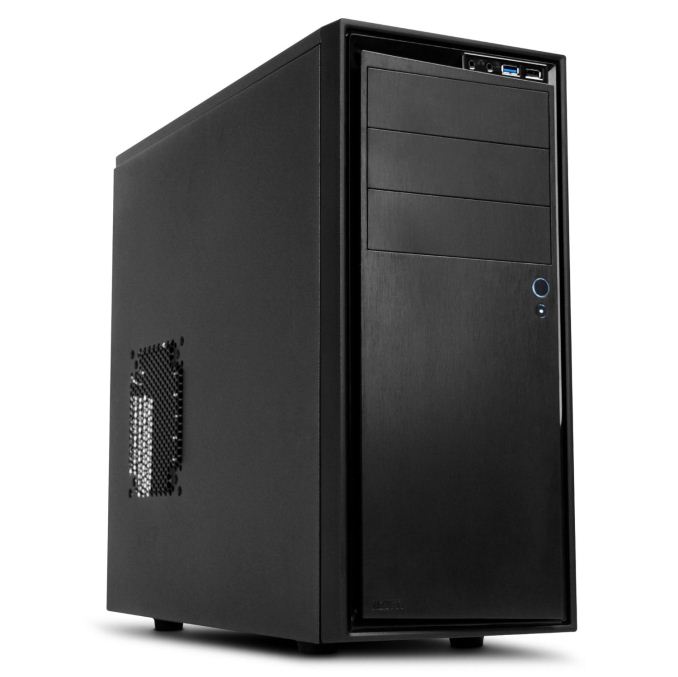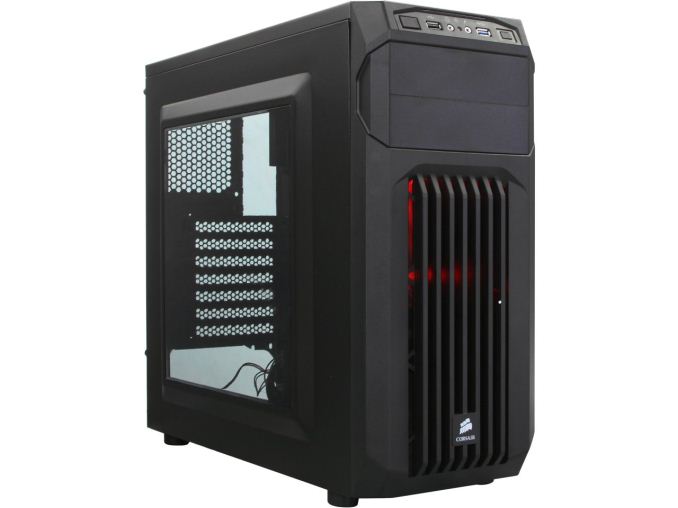Best PC You Can Build for Under $500
by Jarred Walton on August 1, 2014 11:11 AM EST
With yesterday's launch of AMD's 65W Kaveri APUs, it seemed a good time to give some recommendations for new system builds. We're starting out at the budget end of the spectrum, however, and pricing/availability on Kaveri generally rules it out. We'll keep things short and look at two builds, one AMD and one Intel. Outside of the CPU/APU and motherboard, parts are generally interchangeable.
| Budget AMD System | ||
| Component | Description | Price |
| CPU | AMD A6-6400K (2x3.9GHz, 1MB, 65W, 32nm) | $65 |
| Motherboard | MSI A88X-G41 | $73 |
| RAM | Team Vulcan 8GB (2x4GB) DDR3-2133 CL10 | $71 |
| Storage | Seagate Barracuda ST1000DM003 1TB | $55 |
| SSD | SanDisk Ultra Plus SDSSDHP-128G-G25 128GB | $60 |
| Case | NZXT Source 210 S210-001 | $40 |
| Power Supply | Seasonic SS-300ET 300W 80 Plus Bronze | $38 |
| Total (without OS) | $402 | |
The Kaveri APUs provide a decent blend of general and gaming performance, but finding one priced reasonably for a budget system is still a bit difficult (depending on your definition of budget, of course). While the idea of an inexpensive system capable of running games is fine, the cost to go from the A6-6400K we've selected to one of the Kaveri A10 models is more than the cost of a moderate dedicated graphics card like the R7 250, and the A6-7400K and A8-7600 are hard to find – and when you can find them, they're priced $15 higher than the MSRP. If you can wait a bit, the A6-7400K and A8-7600 should become more readily available. In the meantime, the A6-6400K will provide similar performance with a slightly slower graphics configuration.
 For the rest of the system, the MSI motherboard can support both existing Richland APUs like the A6-6400K we've selected as well as Kaveri APUs. Similarly, the DDR3-2133 RAM can provide better bandwidth than DDR3-1600 RAM that would only save you a buck. For storage, you've got three options: go pure SSD and have fast storage performance but without a lot of capacity, buy the 1TB HDD and sacrifice performance for capacity, or get both. Personally, I'd go with a pure SSD or the SSD+HDD configuration.
For the rest of the system, the MSI motherboard can support both existing Richland APUs like the A6-6400K we've selected as well as Kaveri APUs. Similarly, the DDR3-2133 RAM can provide better bandwidth than DDR3-1600 RAM that would only save you a buck. For storage, you've got three options: go pure SSD and have fast storage performance but without a lot of capacity, buy the 1TB HDD and sacrifice performance for capacity, or get both. Personally, I'd go with a pure SSD or the SSD+HDD configuration.
Wrapping things up, the case is a decent looking and not too expensive NZXT Source 210. Cases can be a very subjective topic, and there are plenty of reasonable options, but the NZXT is a good choice for a budget build. You could also drop down to a micro-ATX case and motherboard, and if that's what you're after the MSI A78M-E45 would be a good alternative. For the power supply, the small increase in efficiency offered by 80 Plus Gold isn't really worth the added cost at this price, and Seasonic makes a good 300W unit that will provide good efficiency for a low-power system like this while still allowing for the use of a moderate discrete GPU down the road should you choose to upgrade.
| Budget Intel System | ||
| Component | Description | Price |
| CPU | Celeron G1850 (2x2.9GHz, 2MB, 53W, 22nm) | $50 |
| Motherboard | Gigabyte GA-H97M-D3H | $80 |
| RAM | Team Vulcan 8GB (2x4GB) DDR3-1600 CL9 | $70 |
| Storage | Seagate Barracuda ST1000DM003 1TB | $55 |
| SSD | SanDisk Ultra Plus SDSSDHP-128G-G25 128GB | $60 |
| Case | Corsair Carbide Series SPEC-01 | $50 |
| Power Supply | Seasonic SS-300ET 300W 80 Plus Bronze | $38 |
| Total (without OS) | $403 | |
The Intel budget build is going to provide a pretty similar experience to the AMD build overall; single-threaded performance will be a bit higher, but graphics performance will be lower. The price for these two builds is equivalent at around $400 – which includes both a 128GB SSD and a 1TB HDD, so you can shave off $50 by dropping one or the other storage option. The Celeron G1850 is Intel's least expensive Haswell option right now, and while budget CPUs aren't going to win in any performance contests, for normal tasks they're still plenty fast. Paired with a 128GB SSD they can make for a decent home/office system and the price is certainly appealing. Overclocking isn't really a goal of either of these builds, and Gigabyte's GA-H97M-D3H should do fine for stock clocks.
 The one other noteworthy change is that we've included a slightly more expensive (and perhaps a bit too gaudy for some) Corsair Carbide SPEC-01 case. It has lots of angles and vents, and while Corsair has made some very good cases opinions on aesthetics are still up for debate. It ships with two 120mm fans for cooling, which is going to be overkill for a budget build like this but will give you room to grow. It also has a case window and red LED lighting for those that want to show off a bit.
The one other noteworthy change is that we've included a slightly more expensive (and perhaps a bit too gaudy for some) Corsair Carbide SPEC-01 case. It has lots of angles and vents, and while Corsair has made some very good cases opinions on aesthetics are still up for debate. It ships with two 120mm fans for cooling, which is going to be overkill for a budget build like this but will give you room to grow. It also has a case window and red LED lighting for those that want to show off a bit.
Of course we're still missing the OS, keyboard, mouse, and display; these are all commodity items and most people have existing accessories they can carry over from an old PC. Unless you're running a free OS like Ubuntu or some other flavor of Linux, the cost of Windows is going to represent a significant increase in price of nearly $100, putting us at the $500 mark referenced in the title. Adding a 20" to 22" LCD will tack on another $100-$140, and a keyboard and mouse will be $25 combined for a basic set. So all told if you want a complete new PC the price will be closer to $650, but $500 for the core system and software is a good starting point. You can also find some mail-in rebates on quite a few parts that might drop the price a bit, but as those change regularly I haven't included any in the above tables.










85 Comments
View All Comments
bah12 - Friday, August 1, 2014 - link
Agreed. Maybe it was done to make AMD look viable? I don't know but for $13 more you can get into the Pentium class chip over the Celeron. Why they chose to prioritize cosmetics over power is questionable. Be different if it was just a higher model Celeron, but that money gets you up a whole tier of models.Dribble - Friday, August 1, 2014 - link
Title is incorrect - it should read "Best PC you Can build for $400", or if mouse/keyboard/monitor is included it's "Best PC you can Build for under $650".Assuming the $400 totals you came up with are what you meant then you can build a significantly better PC then either of your suggestions with that extra $100 which for some reason you haven't spent.
JarredWalton - Friday, August 1, 2014 - link
I used $500 because, let's be honest: unless you're pirating Windows, you need to buy the OS and that's $100. I could add it to the tables to hit the $500 mark instead of $400, but I figure it's just splitting hairs. If I said "$400", I'd get a bunch of people complaining about me skipping the OS. Can't please all the people all the time, right? Hahaha....Friendly0Fire - Friday, August 1, 2014 - link
You'd need to say "Best PC you can build for $400/$500/$650, depending on interpretation", which doesn't have the same ring to it...mapesdhs - Friday, August 1, 2014 - link
No need to spend $100 on Windows, just get an orig legit unused OEM pack off eBay BIN
for about $60. I bought 10 of them (Win7 Pro 64bit I mean), all Dell. They come from unsold
business desktops, complete with COA, etc. That's $40 available for something else.
Ian.
ozzuneoj86 - Friday, August 1, 2014 - link
Pretty sure that this is in violation of Microsoft's OEM licensing conditions, since they cannot be transferred. You're basically just exploiting flaws in Microsoft's activation system to not be pestered about having a "non genuine" copy of Windows. It doesn't mean you are doing it the legal way... it just means it works.... though I'd say its far less shady than just plain pirating windows and cracking it, so whatever.
tarheel91 - Friday, August 1, 2014 - link
Best $420 computer with an OS from /r/softwareswap.bah12 - Friday, August 1, 2014 - link
Well to be fair if you are using an OEM copy for yourself you are technically "pirating" windows. The only windows version allowed to be installed on a built computer is a full retail license. Now they've never enforced that, and it likely never will."...you must install the software using the OEM Preinstallation Kit and then resell the PC to a third party. If you install that software on your own PC, you don't have a "genuine" copy of Windows...."
For a more in depth look at the conflicting/confusing process.
http://www.zdnet.com/blog/bott/is-it-ok-to-use-oem...
Honestly I'd love you guys to get someone from MS interviewed and on record that this practices is allowed, because the legal language certainly says otherwise.
Death666Angel - Saturday, August 2, 2014 - link
I'm pretty sure that is not the case at least in some countries. I know MS is oblilgated to sell the OEM/System Builder edition here in Germany via court order. And violating the TOS is different than doing something illegal. In some cases certain parts of a TOS are in violation of law and can be overturned if someone decides to go to court over them.Penti - Saturday, August 2, 2014 - link
Doesn't really matter, and the only country where it seems like OEM is meant for consumers is Japan (with components/peripherals).Nothing stops retailers from selling systembuilder packs, there is no need to bundle the pack with computers or anything, but that doesn't mean and end user is licensed. It's meant to come preinstalled by a third party. The end user doesn't get it's rights directly from the software-pack. Though nothing stops you using that key and media however you wish.
A full Windows license is about the same as the OEM nowadays. It's like 99 USD on Amazon. Plus the Windows 8 (not 8.1) OEM had the personal use clause, which you can move if you have bought it for a previous build. But it's more a hint at unlicensed and pirated OS I guess. I'm pretty sure you violate the copyright too if you have not gained a proper license. Though that is a mix of criminal and civil case for the most part. Unless you distribute copies there won't be much they can or will do any way.